4-step guide on inbound lead qualification: how to qualify inbound leads on autopilot
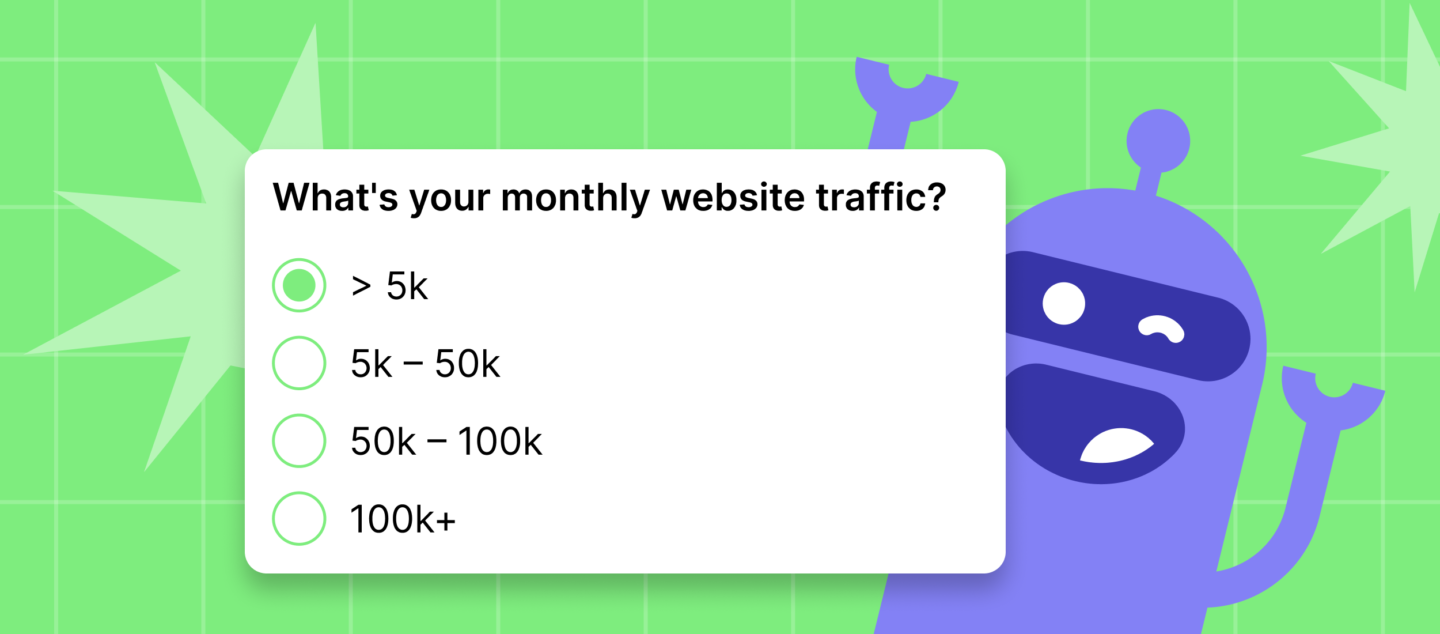
In my experience as a lead qualification expert at Dashly, I’ve seen firsthand how underestimating the need for a focused lead qualification process can harm a business. 73% of your leads aren’t even ready to be sold, the importance of a robust qualification process becomes clear. That’s where a systematic, automated inbound lead qualification process comes in. If you’re part of the score of businesses struggling with lead quality, this guide is for you.
Here’s our 3-step formula, proven with Dashly clients, to qualify inbound leads on autopilot, introducing efficiency and effectiveness to your sales funnel. Because in a world where leads are plentiful but conversions aren’t, the key to growth hinges on recognizing and nurturing potential high converters from the get-go.
Let’s get started.
What is inbound lead qualification
Inbound lead qualification — it’s a marketing strategy that’s all about identifying which leads, or potential customers, are most likely to make a purchase. This process optimizes our focus on interested parties who interact with our inbound marketing and show a real potential to become customers.
Lead qualification example:
Thus, in Dashly, we write many articles. For example, the “Live Chat alternatives: 13 best live chat alternatives for your business” post was published to get demo requests. For this, we placed relevant banners in its content.
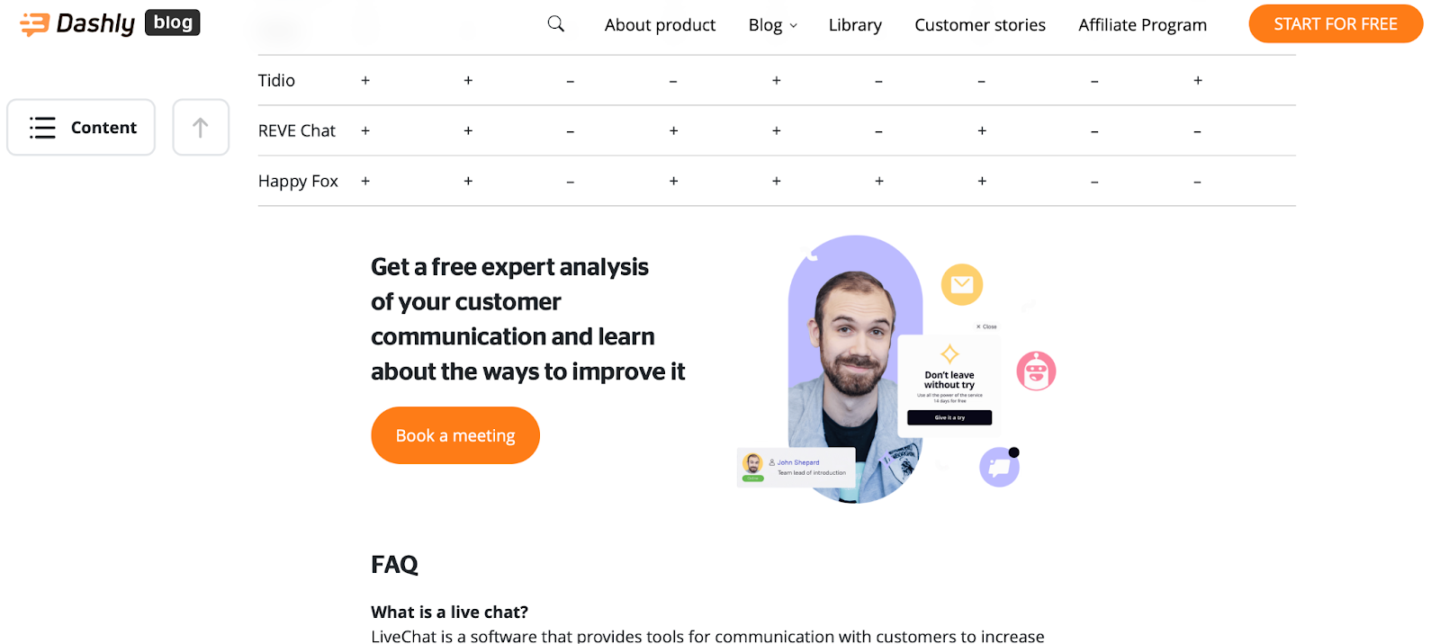
Since this article attracts thousands of readers monthly, our sales managers get numerous requests. But only a few of them are ready to buy. That’s why Dashly marketers added the “What’s your goal?” question to the demo booking form.
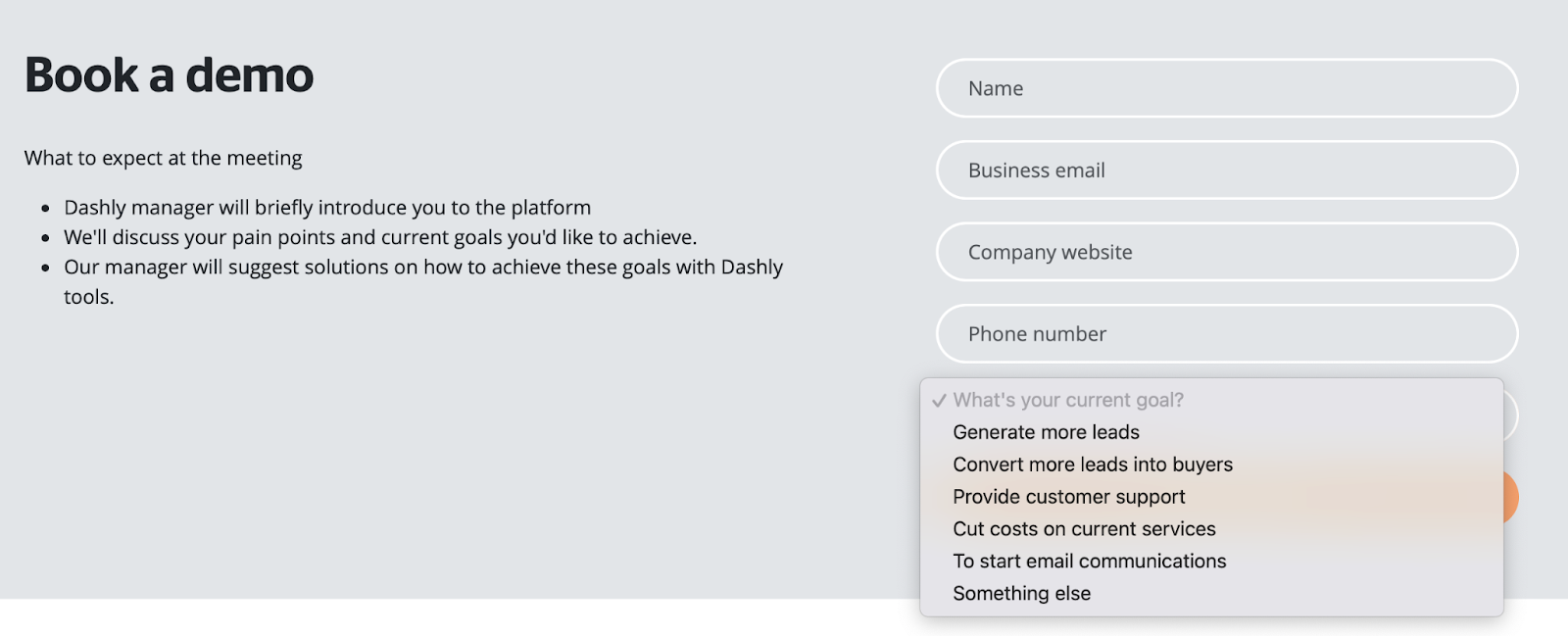
When readers choose the answer from the list, our managers see it in the Pipedrive lead card and can prioritize whom to call first based on the relevance to the ICP.
We also qualify people who register in the Dashly service. Here is how it looks:
- Since the first step to use Dashly is installing the relevant code on a website, the first and most important requirement is a website URL.
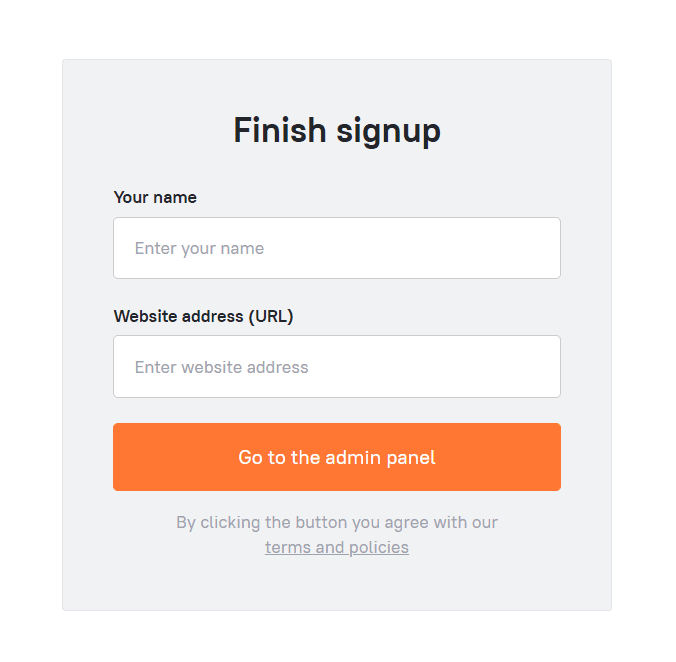
This fact defines that lead can use our tools.
- The second requirement is a position within a company: sales, support, or marketing manager, CEO. Exactly they benefit from Dashly most of all.
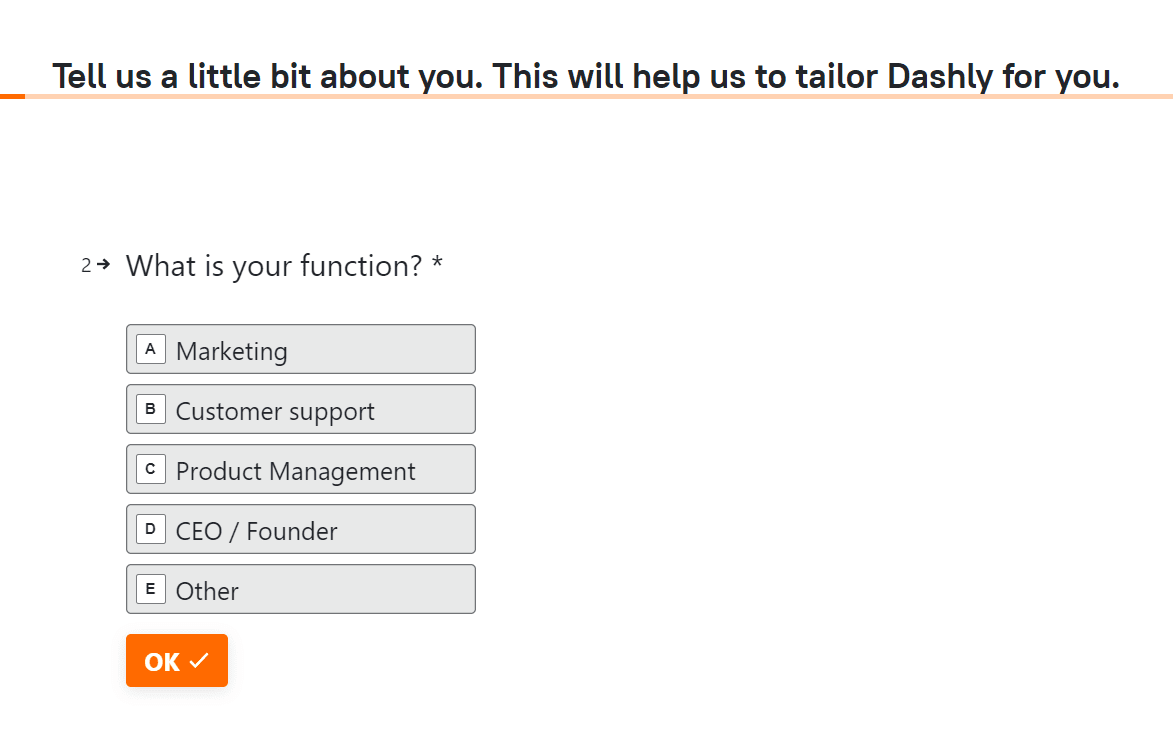
- Company size and website traffic give us a clear understanding of what pricing plan to offer.
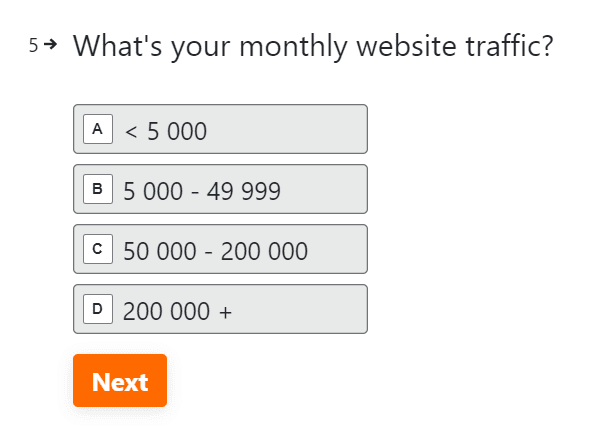
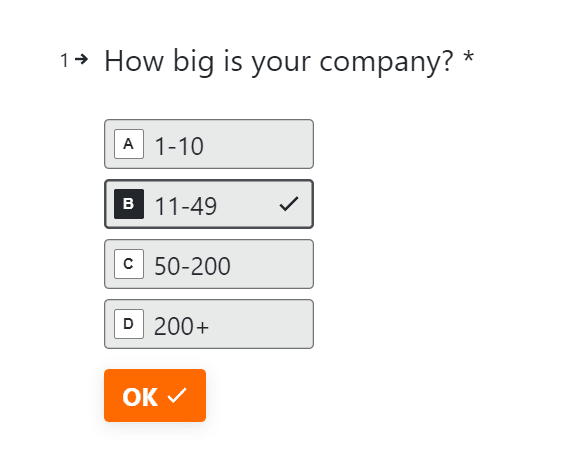
Why qualifying inbound leads is so important
Qualifying inbound leads is crucial for several reasons:
- When you spend time on leads most likely to convert, you optimally utilize resources. According to the Brevet Group, up to 50% of leads are qualified but not yet ready to buy, sorting them helps prioritize follow-ups.
- A qualified lead provides insights into specific needs, enabling personalized communication. A study by Dale Carnegie Training reveals that 29% of sales leads aren’t successful due to a lack of personalized engagement.
- Qualifying leads give you a clear understanding of what a sales-qualified lead looks like, reducing unpredictability in your sales pipeline.
- Qualified leads, being further down the sales funnel, are more inclined to convert into customers. Research by MarketingSherpa shows that organizations that nurture their leads see a 45% lift in lead generation ROI compared to those that don’t.
- Qualifying leads ensure Sales and Marketing teams are aligned, focusing on the same targets. SiriusDecisions reports that alignment can lead to 19% faster revenue growth and 15% higher profitability.
Remember, inbound leads are only as good as your ability to qualify and convert them.
How? Continue reading 👇
5 methods to qualify lead data
Here is a list of tom frameworks businesses use to qualify leads on website before sending them to sales people:
1. BANT
BANT (Budget, Authority, Need, Timing) is one of the most popular qualification frameworks; it has been and still is being applied by very different companies. Using this framework, you can draw up a rather comprehensive view of a potential customer.
In this framework, the potential customer’s budget is a major qualification parameter, and all other criteria come next.
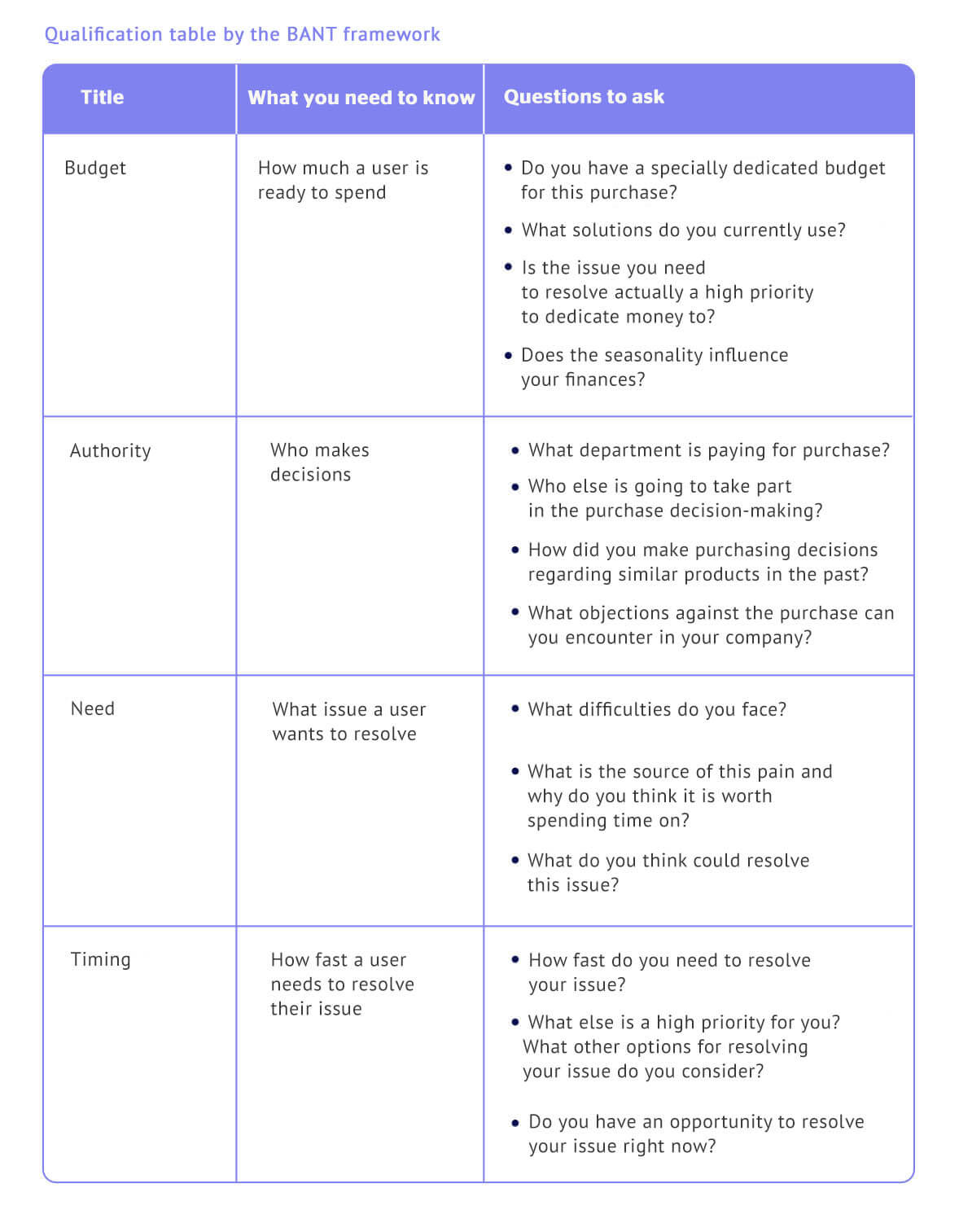
Many sales experts note that the BANT framework underestimates the need of a customer for a purchase assuming that this is less important than their budget and authority. Therefore, let’s examine another model.
2. ANUM
The ANUM model, established by Ken Krogue, refines the principles of the popular BANT approach. It prioritises Authority over Budget (Money).
ANUM segments are:
- Authority: Is your lead a critical decision maker?
- Need: Does your offering solve the lead’s issues?
- Urgency: Will the lead decide promptly, or will it be a prolonged process?
- Money: Can they afford your product or service?
Merits: ANUM underscores authority and hence lead quality right from the start. It lets sales reps identify early on if they should connect with the key influencer in the company or the department, enabling them to refrain from investing time in unqualified leads, thereby saving own and the contact’s time.
3. MEDDIC
The MEDDIC process, developed by Jack Napoli and Dick Dunkel, allows you to understand and assess your audience. This process underscores effective customer qualification — deciding whether you should devote effort into buying your sales funnel.
MEDDIC represents:
- Metrics: How can the solution’s impact be quantified?
- Economic buyer: Who controls the financial decisions?
- Decision criteria: Which parameters are considered while evaluating vendors?
- Decision process: What is the company’s decision-making process?
- Identify pain: What’s the main concern? What’s the cost of not dealing with it?
- Champion: Who can influence the decision process significantly?
Merits: The MEDDIC model enables better comprehension of your leads and helps identify the right people to sell to. Approaching the right people in the right way will drive deal closures. It’s most effective with intricate, enterprise-level B2B selling environments where identifying the key influencers is essential.
4. FAINT
Mike Schultz’s FAINT sales process focuses on five prime determinants to transition your leads into appealing sales leads.
FAINT outlines:
- Funds: Does the lead have the financial capacity for your product?
- Authority: Does the decisive power reside with the lead?
- Interest: Is the lead interested in your solution, or can you ignite their interest?
- Need: Does your solution address the lead’s fundamental need?
- Time: Is the lead open to committing to a deadline for completion?
Merits: FAINT provides a more concise, holistic sales structure than conventional methods, ensuring effective use of time and resources. It assures that pursued leads provide beneficial returns.
5. CHAMP
The CHAMP methodology from Insight Squared presents a lead-centric qualification approach. It emphasizes the lead’s challenge or requirement.
CHAMP embodies:
- Challenges: What hurdles does your lead encounter in their business?
- Authority: Is the lead a critical decision maker in their organization?
- Money: Is there a dedicated budget for this initiative?
- Priority: Is there a timeline to execute this project?
Merits: Implementing the CHAMP pathway keeps sales reps concentrated on helping leads comprehend their challenges. Identifying a challenge creates an opportunity, aiding salespeople in quickly qualifying their leads.”
Step 1 of inbound lead qualification: Define your ICP
The initial stage of lead qualification is incredibly crucial, yet strategic. Nail this step and, with the right tools and effort, the rest will proceed smoothly. We delve into this topic extensively in our article — Ideal Customer Profile — but here’s a brief overview.
Our desirable clients at Dashly typically fall into the SaaS sector, with an annual business range of $1M to $200M. They boast high levels of expertise and often offer customized, often intricate products or solutions necessitating a consultative sale. These companies aim to correlate their business growth strategies with elevated website visitor traffic. Being on an active growth trajectory, they’re equipped to invest $1-12K/month into marketing.
At an individual level, we generally need to secure the interest and trust of roles like the Marketing Director, VP of Sales, and President/CEO. We comprehend the challenges they commonly encounter, including:
— Scarcity of qualified leads;
— Lack of sync between marketing and sales team;
— A meager or absent pipeline of inbound, sales-qualified leads;
— Overwhelmed with serving existing customers to aggressively pursue new business;
— Uncertainty regarding the productivity of marketing expenditure.
As we’ve taken the effort to identify and document these points, implementing our lead qualification system was relatively straightforward. Simply put, we know our buyer well. Hence, as long as we introduce the right processes and tools, we can promptly determine the quality of leads.
Before venturing into lead qualification, it’s vital to know the attributes to seek in a prospective customer. The optimal way to understand this is by identifying how your ideal customer “appears”.
Consider your Ideal Customer Profile (ICP) as the kind of company that would gain exceedingly from your product or solution. Your ICP should encompass firmographics like technographic data, funding or IPO status, company size, revenue, industry, and location.
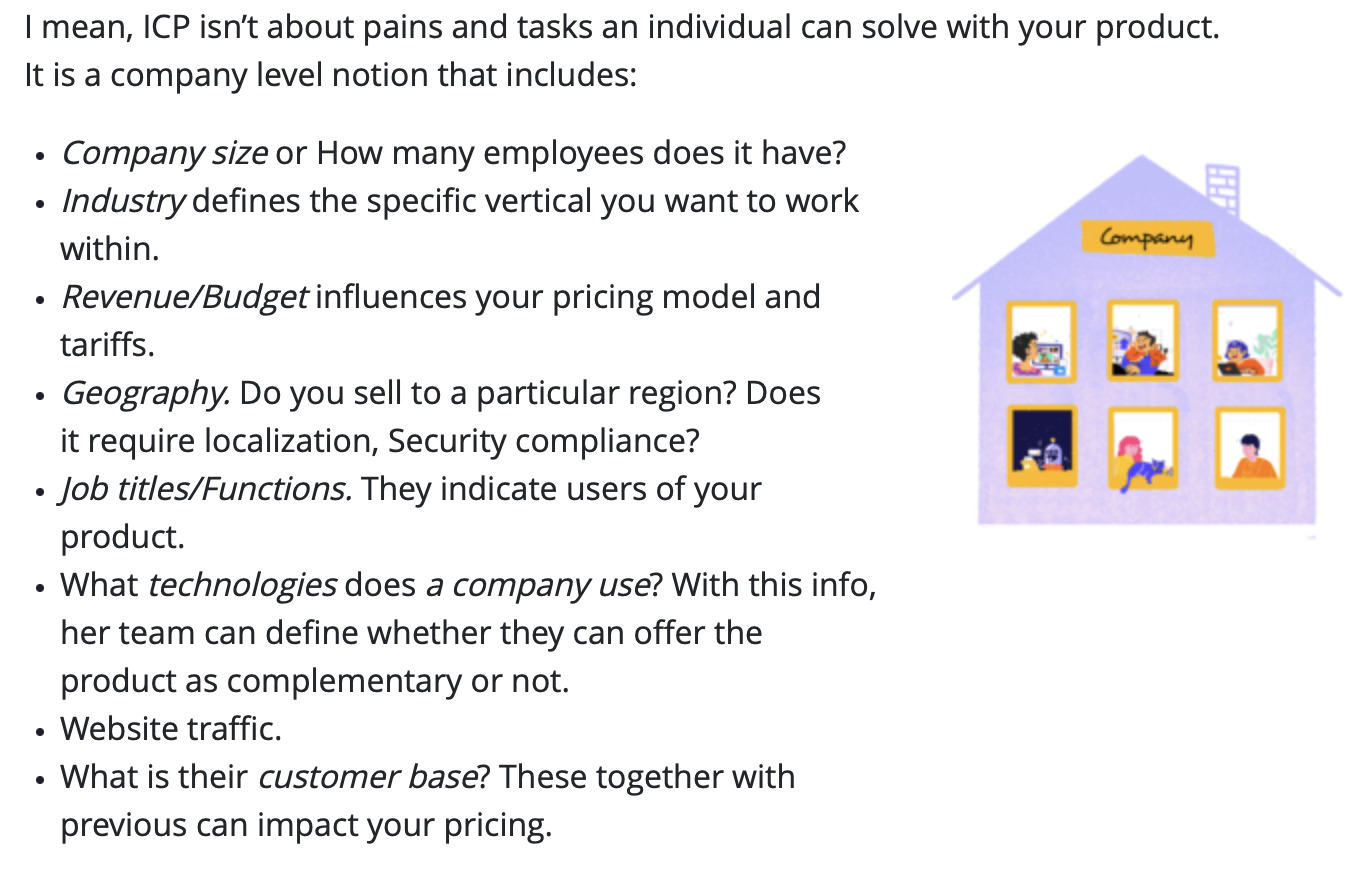
Grasping this information before initiating the lead qualification process is pivotal. It will steer you to make informed decisions about which leads are worth advancing in the sales cycle and worth the time and resources to convert leads into customers. Ultimately, it’s a learning journey, where your every decision shapes your team’s direction and the emails you send out!
Step 2: Lead scoring as a part of lead qualification process
In essence, a lead scoring system or model serves as a tool for prioritization, assisting in determining if a lead is qualified, and the ideal timing for engagement. This model assigns varying point values to distinct lead activities such as exploring a specific webpage or opening an email. Here is a an example of assigning scores to different actions depending on how it defines your ICP.
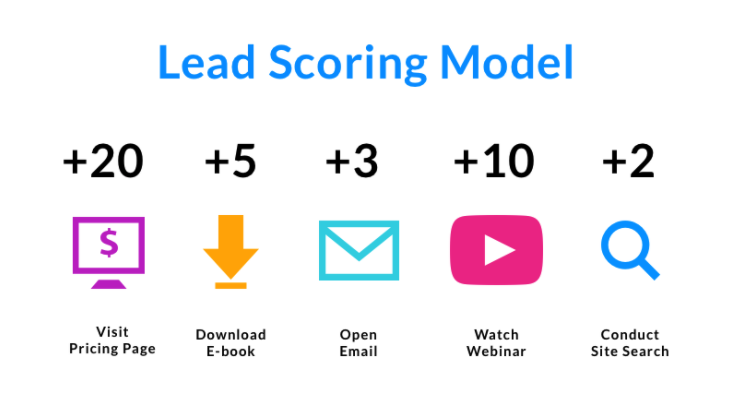
Aggregating these points aids in discerning the stage of the sales cycle a lead is in, thereby, enabling better identification of opportune moments for contact. The example below illustrates how the lead score on the left-hand side equates to a lead’s or prospect’s proximity to decision-making.
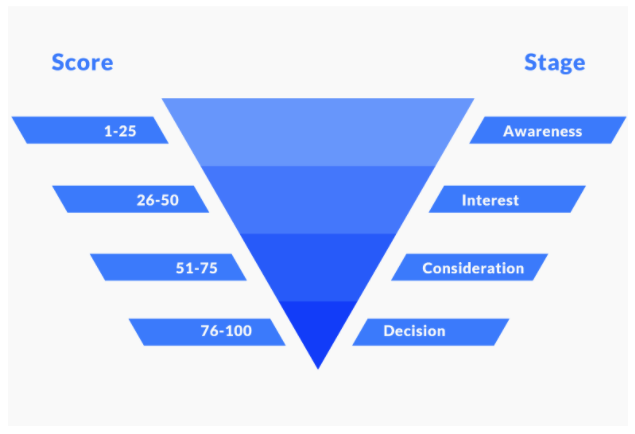
It’s crucial to understand that individual companies will have distinct lead scoring models as the score allocated to each indicator greatly hinges on corporate priorities, offerings, and the technique of sales development.
For example, here is how EdTech companies use lead scoring.
They assign “points” to the key attributes, including the qualifying and behavior information.
The number of points in the scoring system depends on the company, its ICP.
But it’s good to have an example.
Example of the EdTech Lead Scoring system:
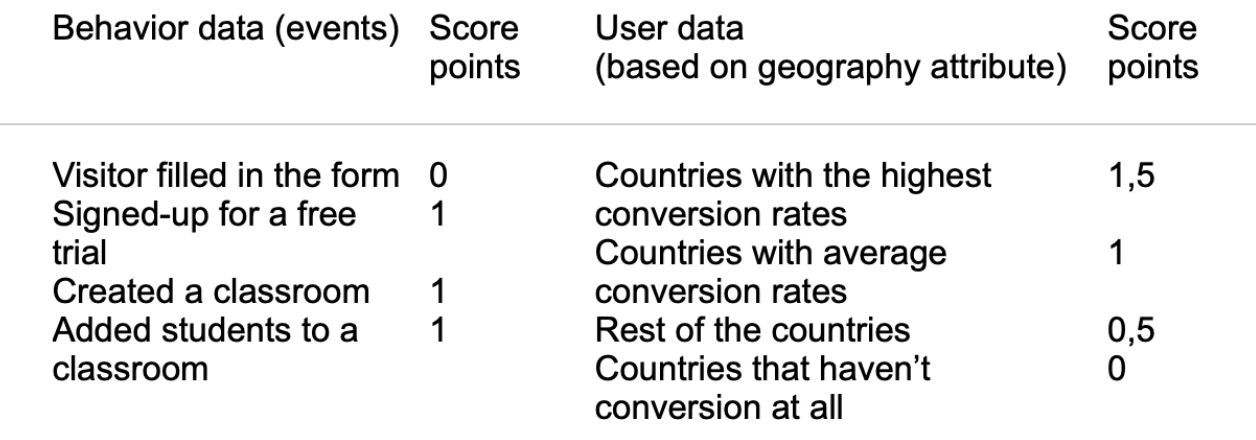
The higher the score, the more likely lead to buying your product. There is no silver bullet on how to set up the scoring system. You need to collect data and analyze it to see who your ICPs are and what they do before they purchase the products.
Pro tip: It’s good to experiment with the value of points of each attribute and review it on a regular basis.
It’s clear what to do with the hot leads who hit the scoring threshold — hand them to your sales team ASAP. What about the rest?
Step 3: Automate an inbound lead qualification process
At this point, the most strategic part of the job is already behind you. You’ve identified the characteristics of a good lead. Now you need to teach your website how to screen inbound leads based on those same criteria.
For this step, I’m operating under the assumption that you’re using a marketing automation software. If you’re not, don’t worry. Read on anyway. You should be aware of what’s possible because automation can save you a ton of time. Dashly clients use chatbots and popups for this goal:
- Add qualification questions to the contact form, pop-up, or chatbot flow you use to capture a lead.
- Track lead behavior on the website.
- Make sure all this data is stored in one CRM.
- Assign points to the lead parameters that fit your ICP.
- Based on the lead score, call it or add it to the mailing list for marketing campaigns.
In Dashly, all the data captured by a chatbot, pop-up, lead form, or user tracking tool goes to CRM, lead card, inbox, and agent email.
Here is how it looks in Dashly:
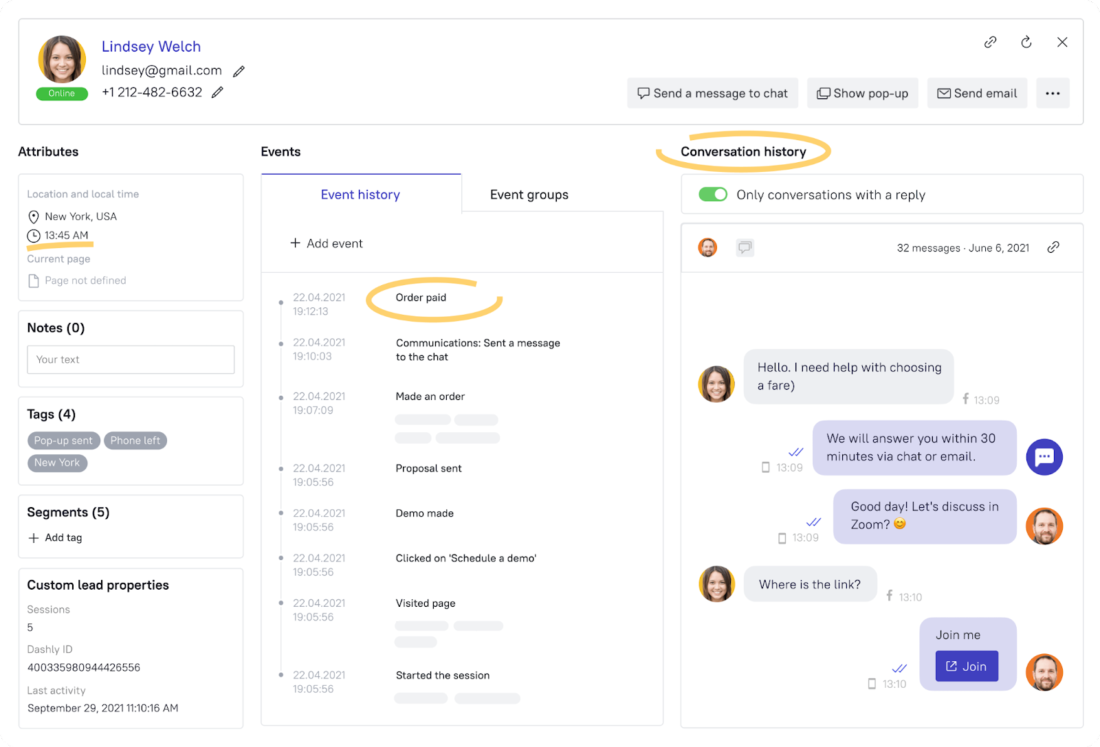
Lead card with all the info about a customer.

Notification about a lead with all relevant info goes to a relevant sales channel.
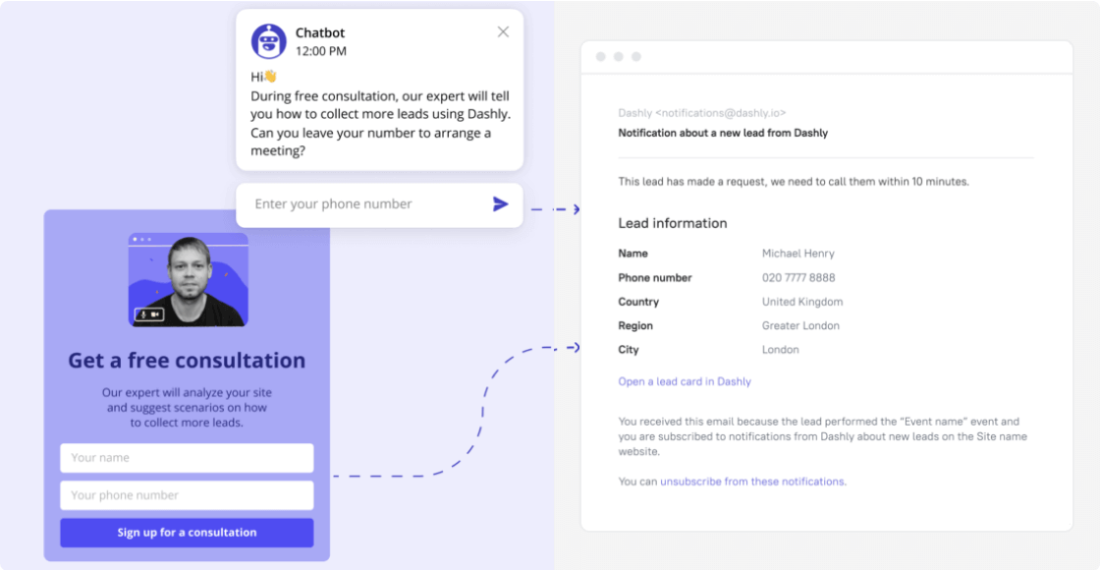
Agent notification about new lead by email.

Lead transfer to your CRM.
One place to store all the data about leads accessible for marketing and sales.
Step 4: Assign some homework before calling qualified leads
Pass along articles and resources to a lead, and don’t get on a call until they’ve read them.
The Dashly lead card will show you what pages were visited by your lead before asking for a demo.
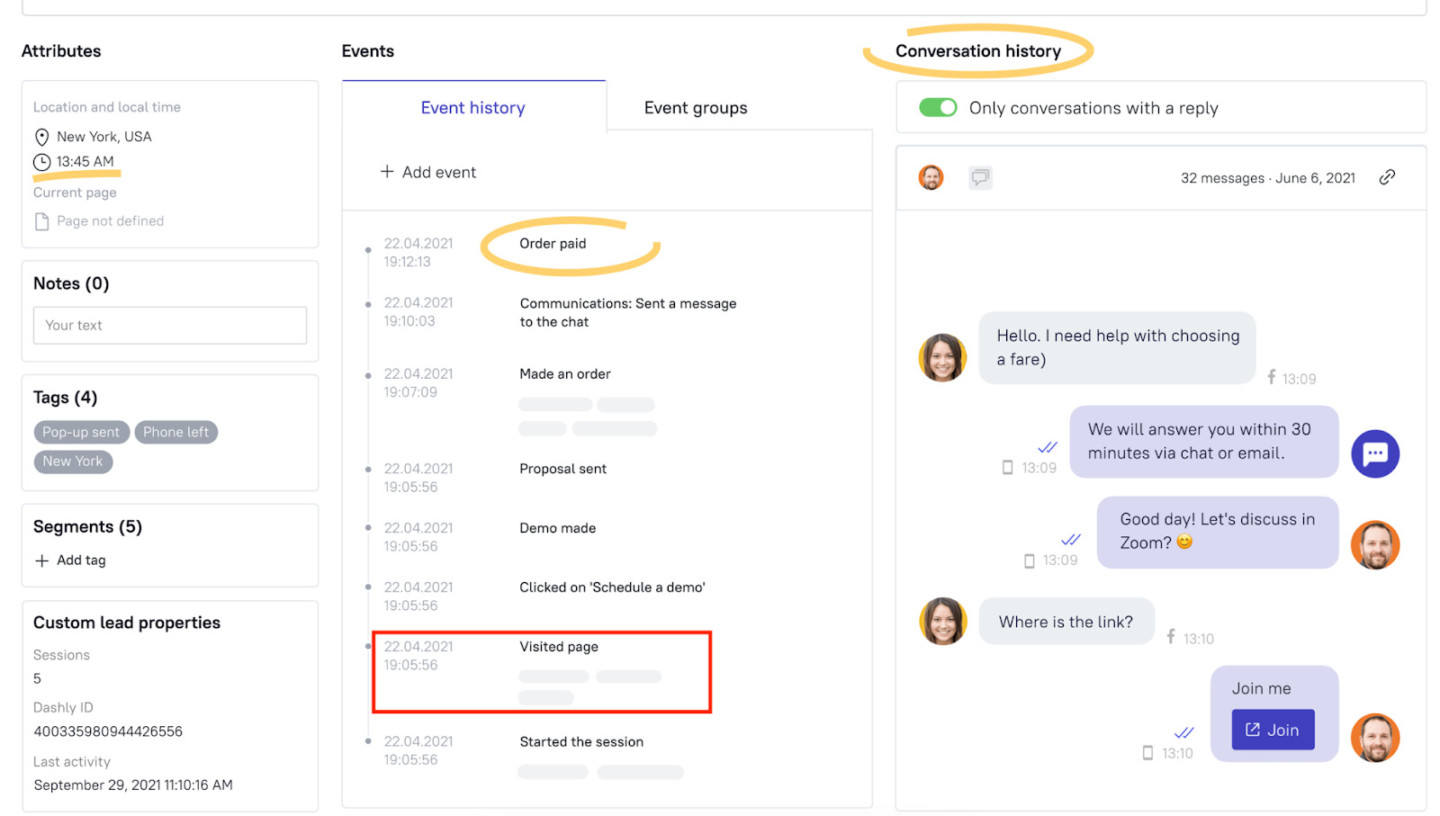
By strategically educating your lead before initiating a sales conversation, you can not only set the stage for a more effective dialogue but also discern the truly engaged leads. Consider existing website content that might address your lead’s typical queries and also help assess the degree of his or her interest. Locating this content relevant to specific stages of the buyer journey can help illuminate their engagement level — find it and circulate it.
5 website lead qualification tools to grow your revenue
There are several tools you need to qualify leads. The formula is simple:
Tool to capture user data + User tracking tool + CRM
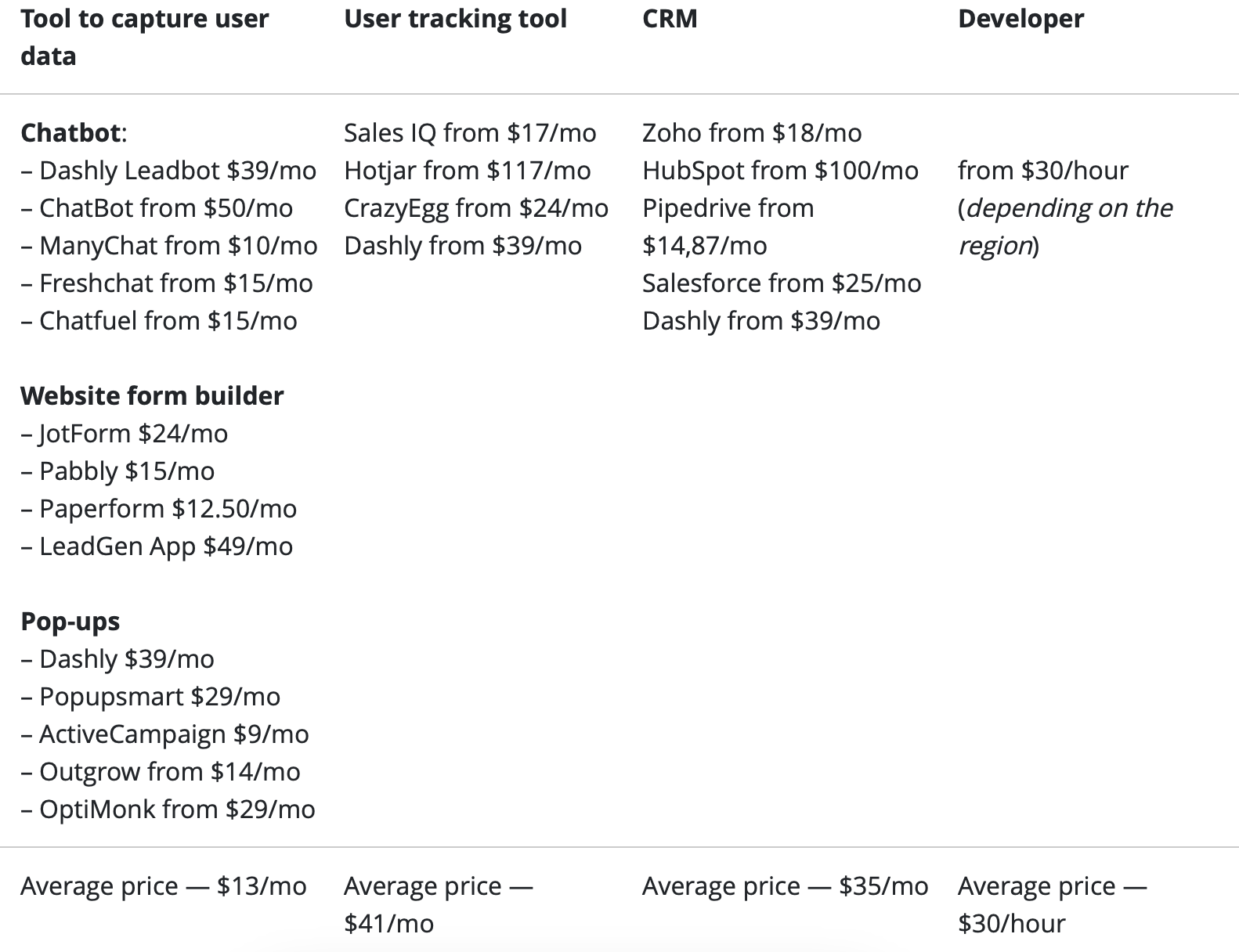
So what are the options? Here is a list of the best:
Dashly is an inbound lead qualification service. It provides the next
- Lead Qualification Features: chatbot, popups, and website visitor tracking that send collected data to the leads card and your CRM. You can use Visual Builder to create any conversion flow with any type of answers.
- Trial: 7 days.
- Price: starts at $39/mo.
HubSpot
- Lead Qualification Features: HubSpot has a multitude of lead qualification features including lead scoring based on predetermined criteria, integration with CRM to track interactions, and behavior and lifecycle stage tracking.
- Trial: HubSpot provides a free trial for new users.
- Price: The starter plan begins at $50 per month.
Intercom
- Lead Qualification Features: Intercom features real-time data collection, automated lead qualification based on data, and customized messaging for better engagement.
- Trial: Intercom offers a 14-day free trial.
- Price: Pricing starts at $39 per month for their basic plan.
Marketo
- Lead Qualification Features: Marketo provides advanced lead scoring, detailed customer profiles, and behavior tracking to help with lead qualification.
- Trial: Marketo doesn’t offer a traditional free trial, but they do provide a free demo.
- Price: Pricing is personalized based on requirements and can be obtained by contacting Marketo directly.
Pardot by Salesforce
- Lead Qualification Features: Pardot offers strategic lead scoring and grading, prospect tracking across various channels, and CRM integration.
- Trial: Pardot provides a personalized demo but doesn’t have a free trial.
- Price: Pricing starts at $1,250 per month for their basic plan.
Final tips on how to get more inbound leads
Want to know how to get more qualified leads? Follow these tips:
- Maximize your digital marketing strategies and always confirm the contact information you receive for precise targeting.
- Examine the tech stack leads employ on their sites to customize your services suitably.
- Improve your site’s SEO, deliver valuable content, and use social media platforms to reach potential clients.
- Employ email marketing to nurture leads and consider personalizing your outreach efforts.
Stay on top of your game in understanding inbound lead qualification — it’s integral in streamlining your sales process and driving conversion rates. Your goal: qualify, engage, and convert effectively.
FAQ
What are examples of inbound lead qualification questions?
- What’s your industry?
- What’s your job role?
- How large is your company?
- What’s your budget range?
- Which solutions are you using currently?
- What is your main pain point?
- Which product are you interested in?
- What’s the main goal for your visit?
- Are you the decision-maker?
- Looking for long-term or short-term solutions?
Who is an inbound lead qualification specialist?
An inbound lead qualification specialist, often part of a sales or marketing team, is responsible for assessing incoming leads to identify which ones are most likely to convert into customers. They use established processes or systems to score leads based on criteria like interest level, budget, readiness to purchase, and more. Generally, these specialists take the initial contact from leads (usually generated from marketing efforts), qualify them through specific questions or pre-set matrices, and then pass on the most promising ones to the sales team. They play a critical role in ensuring the sales team’s effort is focused on high-potential leads, thereby increasing sales efficiency and conversion rates.
What is an inbound lead?
An inbound lead refers to a prospective customer or client who shows interest in a company’s product or service and is initiated by the prospect themselves. This interest could be demonstrated through a variety of actions such as filling out an online form to download a piece of content, subscribing to a newsletter, making inquiries about the product, or engaging with a company via social media. In contrast to outbound leads generated through cold calling or direct mail, inbound leads come to the company organically, often as a result of their own research or discovery which tends to make them more qualified and easier to convert into customers.
What is an automated lead qualification?
Automated lead qualification is a strategic process used in sales and marketing where technology is used to sort and categorize prospective customers (leads) based on a predetermined set of criteria.
Read also:
- Choose your ideal lead nurturing platform: Top 10 software tested by experts
- The best way to collect emails: 5 top-notch methods unveiled
- How to implement user tracking on website: guide, tactics, and tools
- Top 10 user activity monitoring tools: tracking features, price, cons and pros
- Acquisition funnel marketing: Grow customer conversions at each step of user journey
- The top 15 inbound marketing tools: harness digital power and elevate your business
- Top 12 lead qualification tools to deliver your sales hot leads only
- Top 20 best website tracking tools for effective work with visitors
- Top 10 customer segmentation tools to personalize customer communications
- 10 best website personalization tools to deliver top-notch visitors experience
- 20 AI sales tools: Boost your sales strategy with revolutionary technologies
- 12 best AI marketing tools to automate everything [expert edition]
- Top 12 omnichannel marketing tools for your cross-channel campaigns
- 7 best email capture tools: features and pricing compared for 2024






